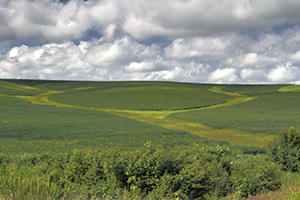
Last week I was in a discussion with Dr. Mark Tomer, ARS National Laboratory of Agriculture and Environment, about the amount of research that exists, or more importantly the amount of research that does NOT exist, on the efficacy of grassed waterways. Dr. Tomer agreed there was very little research done on grassed waterways, but quickly added he could not imagine submitting a project proposal for grassed waterways because it is assumed, by most funding institutions, that grassed waterways are completely researched and understood.
Coincidentally on the same day, I also talked to Dr. Amy Kaleita, ISU Agricultural and Biosystems Engineering, about the same subject. Dr. Kaleita reinforced Dr. Tomer’s assessment; “there is very little research that exists on grassed waterways”. This seems very strange when grassed waterways may be the most important BMPs for protecting water quality.
It is my belief that grassed waterways are an indication of the continued indifference that resource professionals have towards ephemeral erosion. I guess ephemeral erosion must rank low on the “sexy” scale. Thankfully there are a few soil scientists that continue to beat the drum on the damage caused by ephemeral erosion. One of those soil scientists, Dr. Rick Cruse, ISU Graduate Program in Sustainable Agriculture, reminds us of the importance of grassed waterways in addressing our water quality and soil health.
Learn More: Corn & Soybean Digest
I completely disagree with the statement that no research has been done on grassed waterways. Of course most of it was completed before you or I were born. TP-61 was published in 1947. It was a culmination of research by the Soil Conservation Service and the Stillwater Hydraulics Lab. It detailed the allowable velocity that various grasses could withstand on various soils. That allowed the engineers to come up with the size and shape of waterway needed on each site to prevent further erosion.
In the mid 1980s Ag. Handbook 667 was released by ARS regarding further research that was completed regarding the tractive force that could be resisted by various vegetation and soils. Unfortunately it was complicated enough that the publication included an appendix with a basic computer program to accomplish the task. Even though it was an improvement to TP-61, it took a long time before standards were updated to allow it use. Even then it took the incorporation of the concept into the NRCS Engineering Field Tools software in recent years before it could be effectively used.
The biggest problem with grassed Waterways is getting them vegetated in a timely manner. Contractors aren’t plentiful anymore that to be available to complete the task when the grass will readily grow. Without immediate grass cover the project is subject to failure before it gets started.
Otherwise, the research competed for TP-61 and AH 667 has been quite effective. However there are few of us around that still remember it.
Owen,
Your response about research on grassed waterways (GWWs) is very much appreciated. When I wrote this post I was not considering all of the past engineering research that occurred. What I intended to say was that there was very little research to determine the efficacy of GWWs on soil erosion and the efficacy of GWWs on water quality. You correctly pointed out that is a lot of engineering research. The engineers have definitely provided adequate research on how to design a waterway to be built and maintained as a stable conduit of water. Now it is time to research how effective grassed waterways are once they are installed.